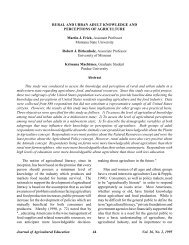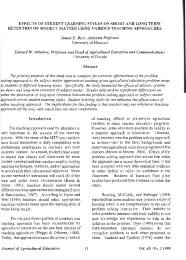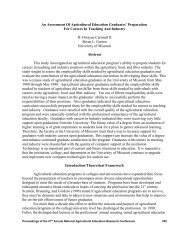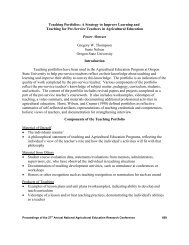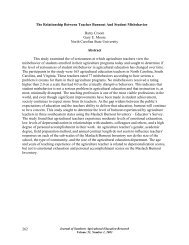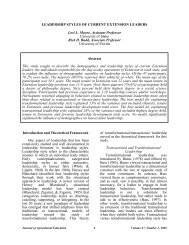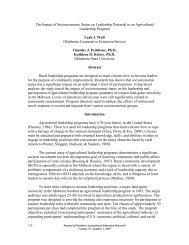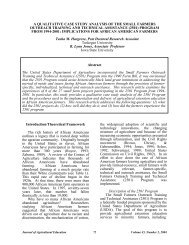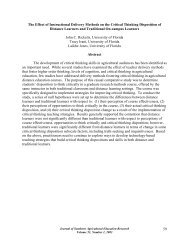Expressive creativity is the type of spontaneous creativity often seen in children <strong>and</strong> isexemplified in drawings <strong>and</strong> play. Scientists <strong>and</strong> artists illustrate productive creativity. Anelement of spontaneous production remains, yet is characterized by the need to create ratherbeing restricted by the need to express. The third classification is inventive creativity that may bedescribed as a problem solving or a creation to improve an existing technology. An examplewould be an engine invented to make farm tractors more fuel-efficient. Innovative creativitydeals with the capacity to improve or reinvent an existing organism or object through theutilization of conceptualization skills. An example is the recent movement to reinventgovernment, in which the existing governmental structure was redefined throughreconceptualization. The final type of creative skill is emergenative. It is a new creation openingan entirely new paradigm. An example is the interventions of chemical fertilizers, insecticides,<strong>and</strong> hybrid seeds that helped to launch the Green Revolution. Emergenative creativity is adiscovery that opens an explosion of ideas in a synergetic fashion (Taylor, 1959).In an operationally problem-oriented definition, Torrance (1966) defined creativity as:A process of becoming sensitive to a problem, deficiencies, gaps in knowledge, missingelements, disharmonies, <strong>and</strong> so on; identifying the difficulty; searching for solutions,making guesses, or formulating hypothesis about these deficiencies; testing <strong>and</strong> retestingthese hypotheses <strong>and</strong> possibly modifying <strong>and</strong> retesting them; <strong>and</strong> finally communicatingthe results. (p. 6)Figure 2 presents forces <strong>and</strong> factors in the creative thinking process model. This model isone cycle that consists of three distinct phases: (1) an initial catalyst; (2) a gestation period; <strong>and</strong>(3) a problem solution <strong>and</strong> verification phase. In one’s reality, any problem experienced inhis/her livelihood system or expressive creative "seed" could serve as an initial catalyst (Wells,1984). After the initial catalyst, there is a gestation period where one begins to delineate theproblem that he/she wishes to solve. Finally there is a problem solution <strong>and</strong> verification processin which the individual comes up with a proposed resolution or creation which he or she thentests (Wells, 1984).Gestation Period(Problem Delineation, Incubation,Illumination)InitialCatalyst(Stimulusevent)Catalysts <strong>and</strong>InhibitorsInterpersonalVaiablesAttributes of CreativityCatalysts <strong>and</strong>InhibitorsCulturalVariablesProblemSolution <strong>and</strong>VerificationCatalysts <strong>and</strong> InhibitorsEducational VariablesCatalysts <strong>and</strong> InhibitorsFigure 2. <strong>Creative</strong>Biological Variables 1Process Cycle176 Journal of Southern <strong>Agricultural</strong> Education ResearchVolume 51, Number 1, 2001
The gestation phase includes four groups of often overlapping catalysts/inhibitors ofcreativity. These are encountered throughout life <strong>and</strong> either stimulate <strong>and</strong>/or limit one’s capacityto be creative. Wright (1987) listed the factors that influence a creative home environment as“respect for the child, the stimulation of independence <strong>and</strong> enriched learning environment" (p.34). Pratt-Summers (1989) found similar results to the one described above. Jausovoc (1988)<strong>and</strong> Dorner (1979) discovered that the teacher's teaching style (based on Piagtian cognitivetheory: exercise training, tactical training, <strong>and</strong> strategic training) was related to the developmentof creativity in students. These results support the notion that interpersonal variables areimportant catalysts <strong>and</strong>/or inhibitors of creativity.The second group of catalysts <strong>and</strong> inhibitors consists of biological variables such as age,genetics, health status, <strong>and</strong> gender (Krippner, 1991). The majority of the research has beenconcentrated on gender <strong>and</strong> birth order. There is not a consensus on the impact of gender uponcreativity. Torrance (1983) wrote, "a substantial body of evidence indicates that males <strong>and</strong>females perform at similar levels of tests designed to measure creative potential" (p. 134). Hefound that girls did not perceive themselves to be inventors <strong>and</strong> were largely influenced by theirenvironment. Harriss (1989) found that women were discouraged from becoming artists.Torrance <strong>and</strong> Allioti (1969) discovered that 13 year old girls had higher verbal creative abilitycompared to boys of the same age. Gupta (1979) did not find that there was a significantdifference between boys <strong>and</strong> girls in verbal creative ability, but found that there were distinctelements of non-verbal ability in which each scored significantly higher. The research on theimpact of birth order has detected that first-born males <strong>and</strong> females scored significantly higheron creativity tests than the second born (Comeau, 1980; Jaraial, 1985). The unique contributionof age, genetics, <strong>and</strong> health status to creativity is unclear.The third catalyst/inhibitor group is cultural variables. Krippner (1991) defined these associo-economic status, ethnic background, religious experience, <strong>and</strong> significant emotionalevents. There is a wealth of research to support the connection between socioeconomic status<strong>and</strong> creativity (Forman, 1979; Cicirelli, 1966; Singh, 1970; Kaltounis, 1974; <strong>and</strong> Torrance,1963). The exception to this was discovered by Warden <strong>and</strong> Pratt (1971) who found no divisionin creativity between any ethnic or social class.Cultural background was found to have an impact upon creativity of individuals fromJapan (Torrance <strong>and</strong> Sato, 1979), India (Sharma <strong>and</strong> Naruka, 1983; Torrance, 1981), the UnitedStates, Western Australia, Western Somoa, Germany, (Torrance, 1981) <strong>and</strong> the DominicanRepublic (Baker et al. 2000). Sharma <strong>and</strong> Naruka (1983) found a creative difference between theHindu, Muslim, <strong>and</strong> Christian religious groups in India.Torrance (1986) suggested the way that significant emotional events may affect creativeexpression when he wrote: "apparently, an intense emotional experience sets up a need forcreative expression <strong>and</strong> actually facilitates the creative expression" (p. 130).The final group of catalysts <strong>and</strong> inhibitors consists of personal attributes/educational factors.These include learning style, critical thinking, knowledge, motivation, creative response style,Journal of Southern <strong>Agricultural</strong> Education Research 177Volume 51, Number 1, 2001




